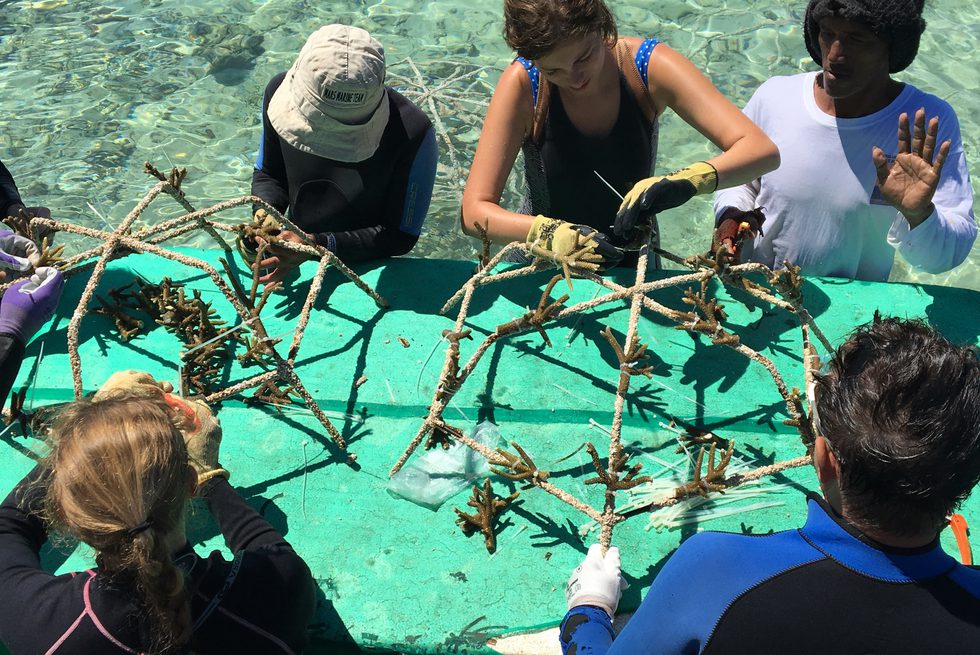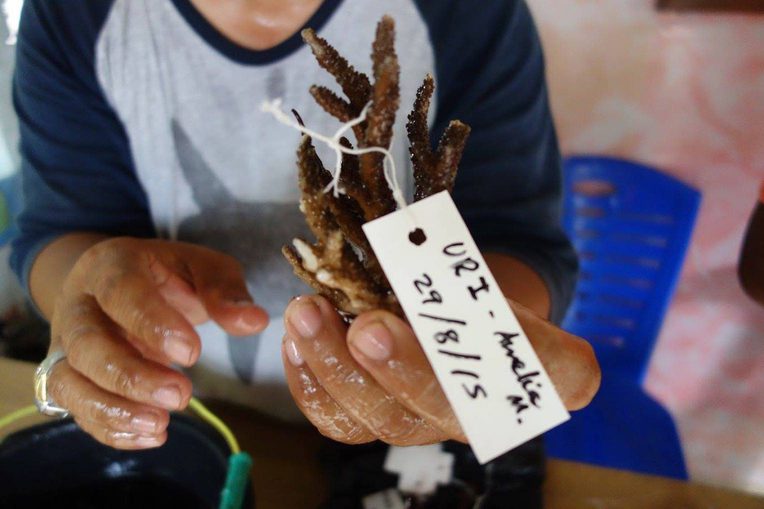Working Together to Restore the Reef: Naturalizing Corporate Forms of Coral, Labor, and Responsibility
From the Series: The Naturalization of Work
From the Series: The Naturalization of Work

The damp coral fragment in my hand is small, brown, and branching. I have selected this fragment of Acropora out of a bin of dozens of similar fragments. An employee from a local NGO quickly takes my fragment, attaches a tag to it, and hands it back to me. “Write the name of your organization,” he says to me in careful English. “Don’t leave the coral out of the water for long.” I dash off the name of my university on the tag and hand the coral back to the employee. He pauses so I can snap a photo, before placing the fragment gently back in the bin and turning to the next visitor.

There were dozens of us in this group of foreign visitors to Indonesia’s Nusa Penida Marine Protected Area. The NGO employee told us that “our” coral would be used in a coral restoration effort and anchored to damaged reef areas within the park. As attendees of a sustainable tourism conference, we visitors were participating in a trial run of the park’s coral restoration program, standing in for the tourists whom the park hopes will pay to tag a piece of coral that may one day become part of a rehabilitated reef.
As coral restoration becomes global, certain kinds of coral have been put to work. The Nature Conservancy even has a guidebook that explains how Acropora corals work for reef restoration (Johnson et al. 2011). Acropora, a hard, branching coral genus, comprises most of the coral used in standardized reef restoration projects. The genus grows in thicket-style reefs, providing the structure for ecologies of soft corals, fish, algae, and invertebrates. Acropora are known in the restoration industry as “reef builders.” They can be propagated from wild harvested fragments, producing hundreds of pieces in a matter of months. Fragments can be raised in offshore coral nurseries, repeatedly out-planted to degraded reefs, and readily monitored.
Coral are now part of a new pantheon of species for the Anthropocene: life forms that embody human-driven planetary processes. Like polar bears, invasive lionfish, and even melting glaciers, coral have become indicators of the declining capacity of Earth to support life as we have come to know it (Moore 2012). As the global market for marine products grows, reefs are frequently dredged, bombed, and poisoned to harvest sea creatures. As coastal tourism and development grows, reefs succumb to pollution, sedimentation, and overcrowding. On top of this, the effects of climate change lead to weakening coral skeletons and bleaching events. There is now an international science, conservation, and development movement to enhance resilient reef systems in the Anthropocene (Hughes et al. 2017).
In the quest for donor funding, NGOs and scientists often partner with private industries that see opportunities in coral restoration. One multinational corporation that extracts resources from Indonesia has come up with a possible solution to the problem of reef destruction. It anchors so-called coral spiders in degraded reefs, hexagonal rebar structures with fragments of hard coral zip-tied to their radial arms. The company postulates that spiders can increase coral density, attract reef fish, rebuild fish-based food systems, and encourage local communities to become stewards of their reefs.
This company has partnered with Indonesian and foreign scientists like myself to develop a system that they call “community-based restoration,” organizing island communities into work teams during spider build-out sessions and compensating islanders for time spent on a coral-tying assembly line. This method produces hundreds of putatively living coral spiders within days, transforming the sea floor in the process.
Privately funded restoration combines what I call corporate coral with short-term labor, creating a co-laboring system for the maintenance of artificial reefs and the out-planting of coral fragments. Corporate coral are species like Acropora that “work” for replicable projects. The most effective species have been scientifically identified. Entire cultures of restoration are now designed for particular organisms, ecologies, and economies (see also Claus 2017).
Such corporate projects attempt to transform chaotic reef worlds into working seascapes via the reorganization of human and nonhuman reef-building species perceived to work as one. Islanders and corals are naturalized as workers providing the labor to produce reef units. But this process of incorporation shifts responsibility for degradation from extractive multinational networks to communities. The assumption is that teamwork between company, community, and coral will lead to local stewardship of the restored areas. Within such schemes, anthropogenic reefs are also naturalized as service-providing spaces in need of protection.
Corporate coral looks like care, but care can obfuscate novel forms of exploitation and settlement. Coral are struggling, and responsibility is required from those who profit from industrial-scale extraction, development, and emissions. But the long-term effects of restoration are unproven, and debates rage about what methods are most effective (van Oppen et al. 2017). Can transplanted Acropora survive? Will reef ecosystems revive? What kind of life can corporate coral support? Who will ultimately profit from this work? What if reef-building species refuse to work? Could “working together” to restore the reef leave coral less resilient and more dependent? Stay tuned as the Acropora grows.
Claus, C. Anne. 2017. “The Social Life of Okinawan Corals.” Journal for the Study of Religion, Nature, and Culture 11, no. 2: 157–74.
Hughes, Terry P., et al. 2017. “Coral Reefs in the Anthropocene.” Nature 546: 82–90.
Johnson, Meaghan E., Caitlin Lustic, Erich Bartels, Iliana B. Baums, David S. Gilliam, Liz Larson, Diego Lirman, Margaret W. Miller, Ken Nedimyer, and Stephanie Schopmeyer. 2011. “Caribbean Acropora Restoration Guide: Best Practices for Propagation and Population Enhancement.” Arlington, Va: Nature Conservancy.
Moore, Amelia. 2012. “The Aquatic Invaders: Marine Management Figuring Fishermen, Fisheries, and Lionfish in the Bahamas.” Cultural Anthropology 27, no. 4: 667–88.
van Oppen, Madeleine J. H., et al. 2017. “Shifting Paradigms in Restoration of the World’s Coral Reefs.” Global Change Biology 23, no. 9: 3437–48.